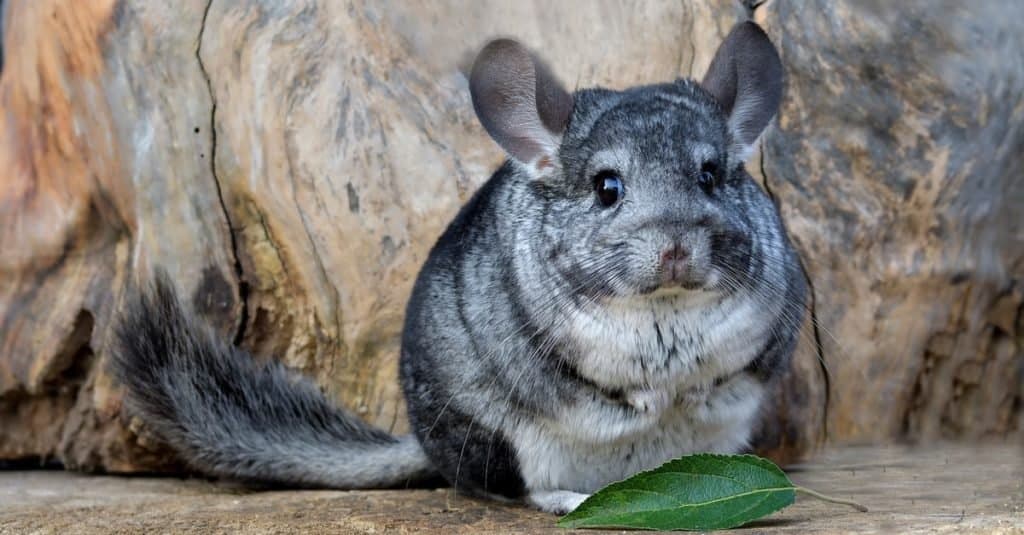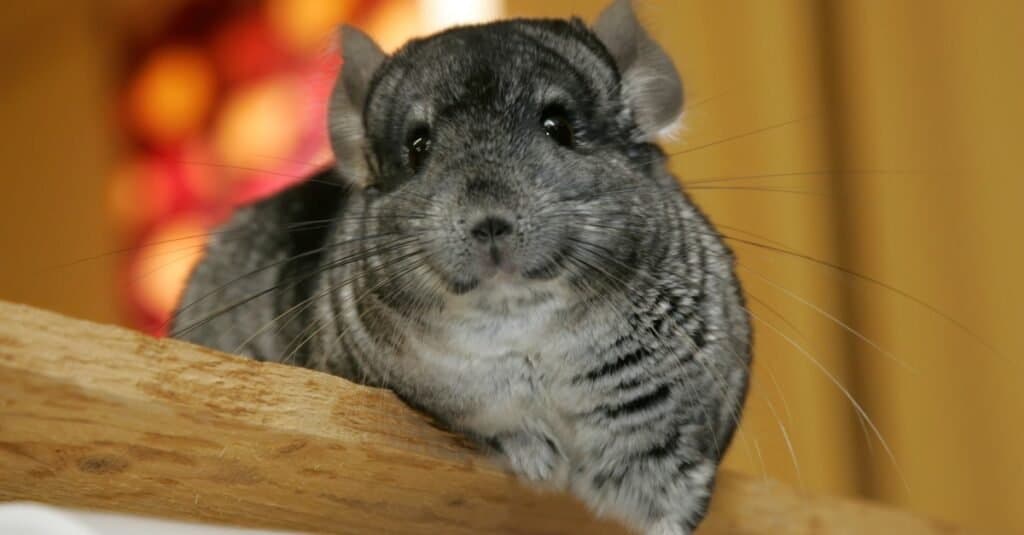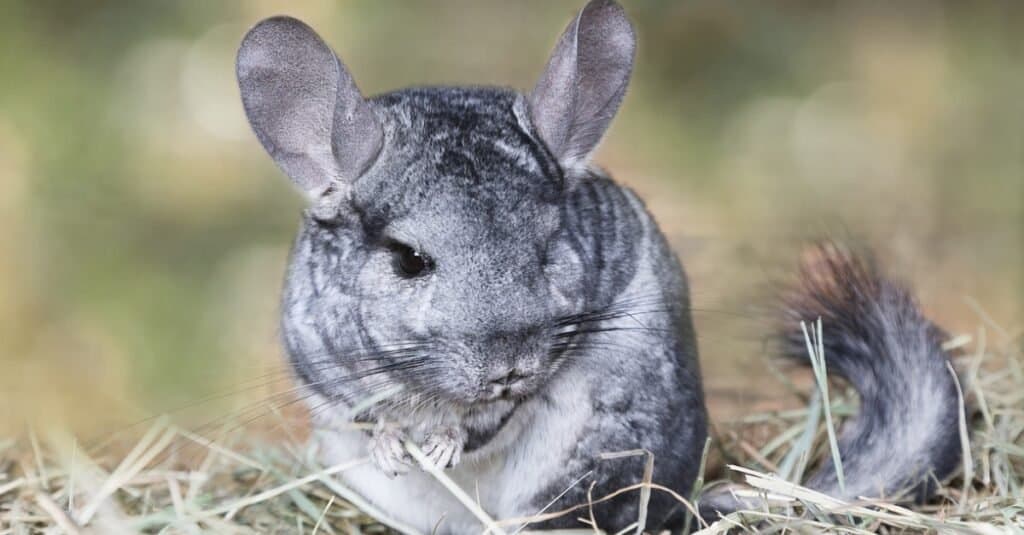Slightly smaller than a house cat, but larger than pet mice, chinchillas may be one of the cutest and most charming rodents in the world! Chinchillas are known to have luxuriously silky, grayish fur that looks so soft to touch, although their original color used to be mottled yellow-gray in the wild, but has evolved into dark blue gray due to selective breeding. Chinchillas also feature rounded ears that add to their already oozing cuteness, and huge, round eyes. Due to their enchanting appearance, these Andes Mountains natives are one of the many rodent species that are often kept as pets, along with hamsters and guinea pigs.
Chinchillas are equipped with thick fur because of their original habitat. These rodents can live at a height of 9,800 to 16,400 feet where it can be very cold. Chinchillas are known to survive in the wild in family groups, where they form plenty of colonies called herds, and look for food. But as tiny mammals who live in such elevations, we can’t help but wonder, what do chinchillas eat?
What Do Chinchillas Eat?

What do chinchillas eat? Well, In their natural habitat, chinchillas are originally omnivores who eat a diet that includes grass, seeds, insects, bird eggs, leaves, bark, and twigs. Although they are labeled as omnivores, their diet consists mainly of vegetation.
In the wild, chinchillas search for their food which mainly include plants and grass. Occasionally, they will include some insects and bird eggs in their diet, but they do not hunt them and will only eat some when they happen to come across one or a group of them. Chinchillas eat almost all sorts of vegetation, such as flowers, roots, cactus fruit, seeds, and shrubs.
Chinchillas are also observed to eat tree bark which is rich in fiber. Fiber is one of the nutrients that chinchillas need in order to survive, and such nutrients should also be present when they are in captivity.
What Do Pet Chinchillas Eat?

As pets, chinchillas majorly eat a variety of vegetation.
©ATTILA Barsan/Shutterstock.com
Chinchillas as pets are mostly herbivores, and they eat a variety of vegetation such as grass hay, fresh fruits, vegetables, chinchilla pellets, roots, and leaves.
As you may expect, domesticated chinchillas eat a slightly different diet than they do in the wild. They have no choice over what they eat and must rely only on their caretakers for their nourishment. Chinchillas in captivity often require a balanced diet of low fat, low moisture, low carbohydrates, and high fiber. Their diet should be composed of about 35% carbohydrates, 3.5% fat, 30% fiber, 15% protein, and only 4% sugar.
Chinchillas can eat leaves and twigs in captivity, yet these types of food are more difficult to find when not in the wild. Hay makes up 75-80% of a chinchilla’s diet, but since most grasses in residential areas have already been sprayed with dangerous chemicals, it’s important to feed pet chinchillas only hay and grass that has been specifically designated for chinchillas.
When planning for a balanced chinchilla diet, there are two important things that must be included: chinchilla pellets and a good-quality grass hay. Alpine, alfalfa, orchard grass, and oats are some good and healthy options for roughage. Pet chinchillas should also be fed only with pellets that are specifically made for them, and not those made for other types of rodents.
What Fruits and Vegetables Do Chinchillas Eat?
Chinchillas must be fed with less sugary fruits and vegetables. They can eat celery, potatoes, sweet potatoes, squash, carrot, alfalfa, and kale regularly.
When it comes to fresh fruit and vegetables, chinchillas can only be fed with these options occasionally and in moderation. Fruits and vegetables should not account for more than 10% of a chinchilla’s diet. Not all vegetables can be a good option for their diet though, so it is still better to feed them with food that contains the nutrients they need, such as fiber. Vegetables like parsley, carrots, dandelion greens, lettuce, kale, collard greens, and turnip greens are good for their diet.
For fruits, chinchillas can eat strawberries and other berries, grapes, pears, raisins, or apples chopped into bite-sized goodness to control their calorie and sugar intake.
How Much Do Chinchillas Eat in a Day?

Pet chinchillas eat one to two tablespoonfuls of pellets daily.
©AJSTUDIO PHOTOGRAPHY/Shutterstock.com
When feeding pet chinchillas pellets, only one to two tablespoons daily will do. For fruit and vegetable treats, on the other hand, chinchillas should be fed only two to four times weekly.
Fruits and vegetables should be fed in moderation because these greens are filled with natural sugar and moisture, which chinchillas are not used to. Chinchillas come from a region with a dry climate, thus their diet has also adapted to their dry surroundings. Too much moisture on fruits and vegetables can lead to bloating. Excess sugar can also be unhealthy for chinchillas and may cause them serious nutritional deficiencies. Too much sugar in their food can also cause obesity, which chinchillas can be prone to.
Domesticated rodents also require constant activities to get their food moving throughout their body in order to keep them from having health problems.
What Do Chinchillas Drink?
The best drink to give pet chinchillas is water. Water is vital for chinchillas, and lack of it can make them fall ill. There should always be fresh water, filtered and without chlorine, ready inside a pet chinchilla’s cage. Water inside a chinchilla’s cage should also be replaced or refilled regularly.
How Often Do Chinchillas Eat?

Chinchillas eat twice a day.
©iStock.com/alkir
Chinchillas in the wild often eat at least twice a day, once at daytime and once during the night. But they may also eat their food throughout the whole day. Since they eat slowly, they may not be able to eat all the nutrients they need during morning and night. Pet chinchillas, on the other hand, are also fed twice a day, but should be constantly provided with hay.
The photo featured at the top of this post is © Creatopic/Shutterstock.com
Thank you for reading! Have some feedback for us? Contact the AZ Animals editorial team.






